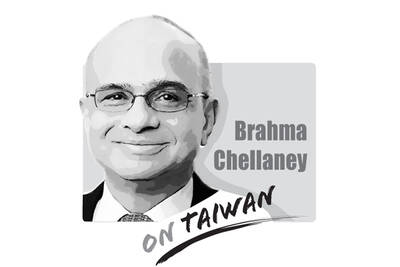Six years since democratically taking power, President Chen Shui-bian's (陳水扁) administration has failed to redress the injustice done to tens of thousands of small landowners whose land was seized as a result of the Chinese Nationalist Party's (KMT) Land Reform Act (實施耕者有其田條例) implemented in 1953.
Transitional justice is an academic term that enjoys a great deal of currency in the Chen administration. It refers to the attempts of newly democratic countries to right wrongs committed by earlier authoritarian governments.
While the Chen administration has managed to render some transitional justice to the victims of the 228 Incident and to at least publicize the issue of the KMT's stolen assets, nothing has been done for the victims of the KMT's land reform.
To implement its land reform program, the KMT government classified Taiwanese farmers as landlords or tenant farmers. The term "landlord" became a synonym for a class of exploiters who were to be eliminated, while "tenant farmer" referred to the vast numbers of the poor who were being exploited.
Research on the KMT's land policy in China, however, shows that the KMT classified and defined farming households very differently before it came to Taiwan.
In 1928, the Central Land Commission issued a survey on land holdings in rural China. The survey divided farming households into five classes: poor peasants, middle class peasants, rich peasants, small and medium sized landlords and large scale landlords.
It defined a small landlord as one who owned the equivalent of 3.07 hectares of land. By this standard, only 6.77 percent of Taiwan's peasant households in the early 1950s qualified as small landlords.
In 1933, the Cabinet issued another study defining Chinese landlords as those who owned at least 5.12 hectares. By this standard, just 2.88 percent of Taiwan's landowners would have qualified as landlords.
And in 1941, the Bureau of Statistics defined a landlord as someone owning 18.41 hectares. By this standard, just 0.9 percent of Taiwan's farming households would have qualified. The Bureau of Statistics identified 1,545 such landlords in its study covering 89 counties in 11 Chinese provinces.
The results of these studies showed that the vast majority of Taiwanese farming households owned less farmland than landlords in China did.
But when the KMT carried out land reform in Taiwan, it reclassified farming households and redefined the meaning of landlord. In effect, practically anyone who rented out land was classified as a landlord, no matter how little land he actually owned.
The result was that a total of 106,049 households were classified as landlords. The vast majority were in fact land owners who rented out land that they owned. Most owned no more than a few thousand square meters. Nevertheless, if these owners had rented their land out, it was appropriated and they lost their titles.
Deprived of the title to their land, many of these former landowners fell into poverty. A contemporary team of observers estimated that more than 2 million people were affected.
Those in power controlled and manipulated land reform in Taiwan by controlling and manipulating the classification and definition of agrarian households to suit their changing needs. The Taiwanese landowners who held titles to their land were of course given no say in the matter.
More than 50 years later, those small landowners -- unfairly labeled landlords -- are still waiting for justice.
Hsu Shih-jung is a professor in the Department of Land Economics at National Chengchi University.
Translated by Michael Fahey
I came to Taiwan to pursue my degree thinking that Taiwanese are “friendly,” but I was welcomed by Taiwanese classmates laughing at my friend’s name, Maria (瑪莉亞). At the time, I could not understand why they were mocking the name of Jesus’ mother. Later, I learned that “Maria” had become a stereotype — a shorthand for Filipino migrant workers. That was because many Filipino women in Taiwan, especially those who became house helpers, happen to have that name. With the rapidly increasing number of foreigners coming to Taiwan to work or study, more Taiwanese are interacting, socializing and forming relationships with
Chinese social media influencer “Yaya in Taiwan” (亞亞在台灣), whose real name is Liu Zhenya (劉振亞), made statements advocating for “reunifying Taiwan [with China] through military force.” After verifying that Liu did indeed make such statements, the National Immigration Agency revoked her dependency-based residency permit. She must now either leave the country voluntarily or be deported. Operating your own page and becoming an influencer require a certain amount of support and user traffic. You must successfully gain approval for your views and attract an audience. Although Liu must leave the country, I cannot help but wonder how many more “Yayas” are still

Earlier signs suggest that US President Donald Trump’s policy on Taiwan is set to move in a more resolute direction, as his administration begins to take a tougher approach toward America’s main challenger at the global level, China. Despite its deepening economic woes, China continues to flex its muscles, including conducting provocative military drills off Taiwan, Australia and Vietnam recently. A recent Trump-signed memorandum on America’s investment policy was more about the China threat than about anything else. Singling out the People’s Republic of China (PRC) as a foreign adversary directing investments in American companies to obtain cutting-edge technologies, it said
The recent termination of Tibetan-language broadcasts by Voice of America (VOA) and Radio Free Asia (RFA) is a significant setback for Tibetans both in Tibet and across the global diaspora. The broadcasts have long served as a vital lifeline, providing uncensored news, cultural preservation and a sense of connection for a community often isolated by geopolitical realities. For Tibetans living under Chinese rule, access to independent information is severely restricted. The Chinese government tightly controls media and censors content that challenges its narrative. VOA and RFA broadcasts have been among the few sources of uncensored news available to Tibetans, offering insights